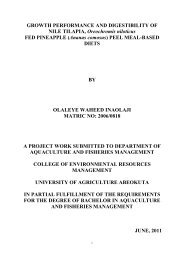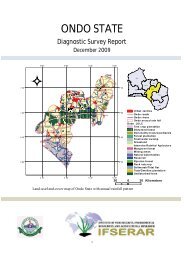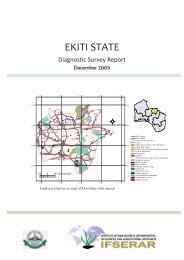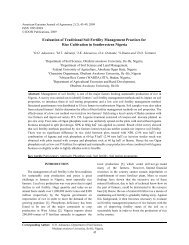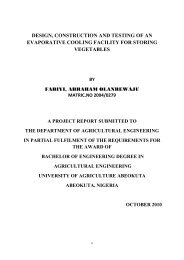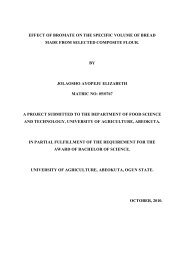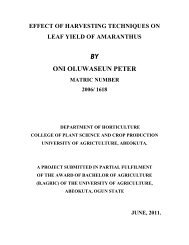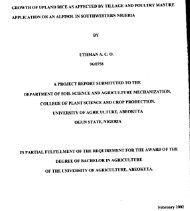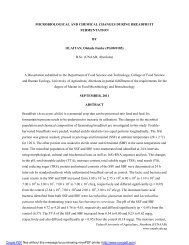presence of aflatoxins in smoked-dried fish sold in abeokuta, ogun ...
presence of aflatoxins in smoked-dried fish sold in abeokuta, ogun ...
presence of aflatoxins in smoked-dried fish sold in abeokuta, ogun ...
Create successful ePaper yourself
Turn your PDF publications into a flip-book with our unique Google optimized e-Paper software.
geographical location. These data suggest that aflatox<strong>in</strong> may <strong>in</strong>hibit growth <strong>in</strong> West African<br />
children (Gong et al., 2002).<br />
In a small study <strong>of</strong> the <strong>presence</strong> <strong>of</strong> aflatox<strong>in</strong> <strong>in</strong> cord blood <strong>in</strong> Ibadan, Nigeria, a significant<br />
reduction <strong>in</strong> birth weight was found <strong>in</strong> jaundiced neonates, who had significantly higher serum<br />
aflatox<strong>in</strong> concentrations compared with babies without jaundice (Abulu et al., 1998).<br />
In a study to <strong>in</strong>vestigate whether <strong>aflatox<strong>in</strong>s</strong> contribute to the occurrence <strong>of</strong> jaundice <strong>in</strong> Ibadan,<br />
blood samples were obta<strong>in</strong>ed from 327 jaundiced neonates and 60 non-jaundiced controls.<br />
Aflatox<strong>in</strong>s were detected <strong>in</strong> 24.7% <strong>of</strong> jaundiced neonates and <strong>in</strong> 16.6% <strong>of</strong> controls. Analysis <strong>of</strong><br />
the data <strong>in</strong>dicated that either glucose-6-phosphate dehydrogenase deficiency or serum aflatox<strong>in</strong><br />
are risk factors for neonatal jaundice; odds ratios were significantly <strong>in</strong>creased: 3.0 (95% CI, 1.3–<br />
6.7) and 2.7 (95% CI, 1.2–6.1), respectively (Sode<strong>in</strong>de et al., 2005).<br />
Aflatox<strong>in</strong>s were detected <strong>in</strong> 14 <strong>of</strong> 64 (37.8%) cord blood samples from jaundiced neonates<br />
compared with 9 <strong>of</strong> 60 (22.5%) samples from non-jaundiced control babies <strong>in</strong> another study <strong>in</strong><br />
Nigeria, but the difference was not statistically significant (Ahmed et al., 1995).<br />
Aflatox<strong>in</strong>s were detected <strong>in</strong> 37% <strong>of</strong> cord blood samples <strong>in</strong> a study <strong>of</strong> 125 pregnancies <strong>in</strong> rural<br />
Kenya, with 53% <strong>of</strong> maternal blood samples be<strong>in</strong>g aflatox<strong>in</strong>-positive. There was no correlation<br />
between <strong>aflatox<strong>in</strong>s</strong> <strong>in</strong> maternal and cord blood. A significantly lower mean birth weight <strong>of</strong><br />
<strong>in</strong>fants born to aflatox<strong>in</strong>-positive mothers was recorded for female babies, but not for males (De<br />
Vries et al., 1989).<br />
In cord blood collected from 625 babies <strong>in</strong> Nigeria, <strong>aflatox<strong>in</strong>s</strong> were detected <strong>in</strong> 14.6% <strong>of</strong> the<br />
samples. There was no significant difference <strong>in</strong> birth weight between the groups positive or<br />
negative for <strong>aflatox<strong>in</strong>s</strong> (Maxwell et al., 2004).<br />
In a study <strong>of</strong> the <strong>presence</strong> <strong>of</strong> the imidazole r<strong>in</strong>g-opened form <strong>of</strong> aflatox<strong>in</strong> B1–DNA adducts <strong>in</strong><br />
placenta and cord blood, 69 <strong>of</strong> 120 (57.5%) placentas conta<strong>in</strong>ed the adduct at 0.6–6.3 µmol/mol<br />
DNA and 5 <strong>of</strong> 56 (8.9%) cord blood samples conta<strong>in</strong>ed the adduct at 1.4–2.7 µmol/mol DNA.<br />
The results <strong>in</strong>dicate that transplacental transfer <strong>of</strong> aflatox<strong>in</strong> B1 and its metabolites to the progeny<br />
is possible (Hsieh, 2003).<br />
A random sampl<strong>in</strong>g <strong>of</strong> semen from adult men, compris<strong>in</strong>g 50 samples collected from <strong>in</strong>fertile<br />
men and 50 samples from fertile men from the same community <strong>in</strong> Nigeria, revealed the<br />
<strong>presence</strong> <strong>of</strong> aflatox<strong>in</strong> B1 <strong>in</strong> 40% <strong>of</strong> samples from <strong>in</strong>fertile men compared with 8% <strong>in</strong> fertile men.<br />
19



